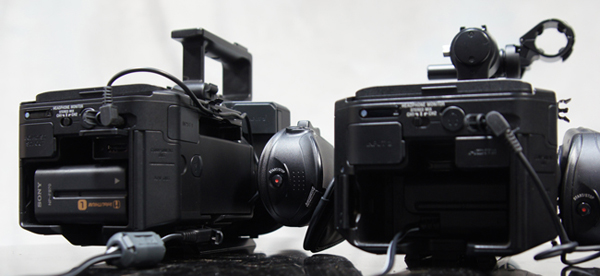Review: Sony NEX-FS700 Large-Sensor Camcorder
The Sony NEX-FS700 has much to recommend it as a top-flight large-sensor, interchangeable-lens camcorder and as a worth-the-upgrade successor to the Sony FS100. And it's 4k support and 10x slo-mo are nothing to sneeze at. But what makes it the best camera in the market for webcast producers?
So moving the expanded focus button from one model to the next makes for a more challenging user experience if you own both cameras. I agree that it is a good idea to make this button available on the handle for those that want to try handheld or rigs, but Sony should have left a duplicate button on the left side for those that leave the side handle in their camera bag and who will be operating with the FS700 on a tripod while they are positioned on the left side of the camera, where the other controls are. A right side button on the top of the camera is out of my sight and reach range for the majority of my work.
I didn’t verify before I had to return the loaner FS700 to my local Sony dealer, Fusion Cine, who were very generous to lend me a FS700 so that I could review it, but I don’t even think that Sony would allow this function to be assigned to the focus hold button that now takes its place.
My perceived value of the new handle with zoom rocker: $600 for equivalent replacement.
LANC Controller Compatibility
The zoom rocker is not operational at this time but it’s a sign that Sony is developing e-mount servo zoom lenses. This much was implied to me by Sony’s Juan Martinez, when I interviewed him at NAB for Streaming Media Producer. FS100 users shouldn’t consider the lack of a zoom rocker on their stock side handle to mean that they will lack this future feature, but I’m not sure if aftermarket LANC zoom controllers, like the ones you used to use on camcorders, will work.
Why, you ask? Atomos reports that their Ninja’s LANC controller doesn’t work with the FS100. What’s more, the FS100 HDMI output doesn’t play well with most recording devices in progressive mode and has embedded timecode. And consider what I’m going to tell you about what Sony did with the power supply on the FS700--all three examples of how Sony is pushing the limits of industry standards but at the same time making their products somewhat incompatible with devices from other manufacturers.
Battery Compartment Configuration
I’ve never really been a fan of the battery-plate adapter that Sony has been using since the Sony Z1U. The simple reason is that it blocks the battery compartment and you can’t use the camera to charge a battery, nor can you have a battery already mounted for when you want to quickly go off the tripod for some hand-held work. The FS100 uses the battery-plate adapter but curiously the FS700 does not. Instead, it uses a flat plug to power the camera, which connects on the lower-right side of the camera. It looks very similar to the connection that was used on the Sony PD150/170 cameras, except the ridges are different, so it is an entirely new connection.

The FS700 uses a different AC adapter (pictured on left with a large ferrite bead) from the FS100 battery plate connector, but Sony does not allow its L-series battery to serve as a battery back-up in case of power loss. The side handle is offset further and now includes a zoom rocker.
If it wasn’t bad enough that Sony changed the type of connection between the FS100 and FS700, they chose an entirely brand new connection that is similar but different from any legacy equipment so that you will have a hard time finding replacement or duplicate power supplies. I still own two power supplies with the older adapters so was able to confirm they are different but otherwise at first glance I assumed they were both the same.
By the way, the FS100 battery plate adapter doesn’t fit in the FS700 battery compartment so be careful if you have third-party adapters as they may or may not fit on the FS700. One of the potential benefits of connecting power to the video camera while the battery is still mounted is redundant power in case of power loss.
Related Articles
Almost Live with Streaming Media reports from NAB 2014 with the latest on the Sony NEX-FS700R and new developments in the E-Mount lens ecosystem.
Shawn Lam compares key models in Sony's large-sensor camcorder line--the new shouldermount NEX-EA50, and the comparatively venerable handheld FS100 and FS700--with an eye to light sensitivity, image quality, and effectiveness with power zoom lenses, and reports on his epic, ongoing search for a viable parfocal 3x+ servo zoom lens.
Part 2 of this series on webcast video production focuses on Sony's NEX-FS100 large-sensor camcorder and new capabilities added via a firmware upgrade that (among other things) makes it compatible with Sony's LA-EA2 lens adapter. While it's not as strong a webcast camera as the FS700 (review coming soon), it still has much to recommend it.
This article will be the first in a series of articles on webcasting and will cover a wide range of topics including video cameras, video switchers, converters, computer inputs, audio, reference monitors, webcast hardware, webcast software, live streaming services providers, and some additional hardware that is important in order to produce a professional live webcast.
An in-depth interview on Sony's new 4K-capable large-sensor camcorder that generated tremendous buzz at NAB 2012 in Las Vegas this week.